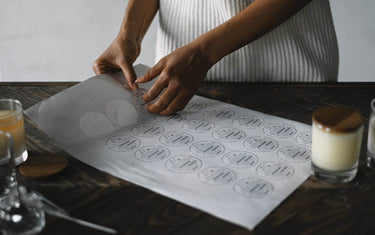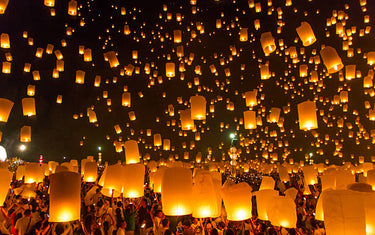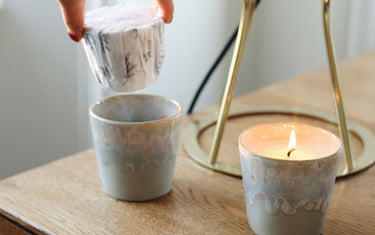5 min read / 16 January 2024 / yasmin sharp
CLP Labels for Candles: A Complete Guide
Master the essentials of CLP labeling for candles, ensuring safety and compliance in your candle-making business.
Share this post

Ensuring you have CLP labels for candles is a crucial part of selling your products to customers.
Not only will it help to keep people safe, but it ensures your business is compliant with the latest laws regarding non-cosmetic products that contain hazardous substances.
Here we explain the basics of how CLP labels for essential oil candles work, giving you an idea of the type of information you need to include and much more.
What are CLP labels for candles?CLP (Classification, Labelling and Packaging) labels for candles is a mandatory requirement for anyone selling candles in the UK that contain fragrance oils or essential oils. These types of oils are classed as hazardous substances and users must be made aware of the potential health hazards. Fragrance and essential oils are not only eye and skin irritants but can also harm the environment if they are not applied or disposed of correctly. CLP labels provide warnings, precautionary statements and safety pictograms where appropriate. |
Do all candles need a CLP label?
CLP labels are only needed for candles or non-cosmetic products that contain fragrance oils or essential oils.
If you are selling candles that do not contain any hazardous substances, then you do not need to include a CLP label.

What information is used on a CLP label?
When creating CLP labels for candles you will need to include the following information:
- Product identifier: Here you can add the name of the candle being sold and the type of fragrance or essential oil included in the ingredients.
- Allergen information: Another requirement for CLP labels for essential candles is displaying the ingredients that could cause an allergic reaction.
- UFI number: Assigning a Unique Formula Identifier (UFI) to a candle ensures it can be identified as an individual product.
- Signal word: If the hazard level of the fragrance or essential oil is severe you must use the word “danger”. Less severe hazards must use the word “warning”.
- Hazard and precautionary statements: This section of the CLP label provides more information about the nature and severity of the hazards. It should also include guidance on how side-effects can be avoided or managed.
- Hazard pictograms: You will need to include hazard pictograms that are relevant to the health risks. Guidelines related to the size, shape and colour of the pictograms must also be followed closely.
- Supplier contact details: The customer must be provided with the full contact details of the selling company, as this allows them to get in touch to discuss any issues related to the product.
Where do I place a CLP label on my candle?
CLP labels should be attached to the packaging that contains the hazardous substances, as this allows the user to read the label before coming into contact with them.
The label should also be clearly visible and readable horizontally when the product is sitting in its correct position.
For candles or packaging that is small or of an awkward shape, you can attach the CLP label using tags, ties or fold out labels.

What is the right size for CLP labels with candles?
CLP label size requirements vary depending on the capacity of the package:
| Package capacity | Label dimensions (mm) | Pictogram dimensions (mm) |
|---|---|---|
| ≤ 3 litres | At least 52 x 74 | Not smaller than 10 x 10 – if possible, at least 16 x 16 |
| > 3 litres but ≤ 50 litres | At least 74 x 105 | At least 74 x 105 |
| > 50 litres ≤ 500 litres | At least 105 x 148 | At least 32 x 32 |
| > 500 litres | At least 148 x 210 | At least 46 x 46 |
These size guidelines also apply to candles, diffusers, wax melts and any other non-cosmetic products that contain hazardous substances.
What is the best material to use for CLP candle labels?
When making CLP labels for candles it’s a good idea to use environmentally friendly materials.
You may already by doing similar with the candle ingredients and packaging, which makes using eco-friendly labels a natural step to take.
Some ideas you can try include:
- Recycled paper candle labels: You can find recycled paper available in lots of different colours that are made with 100% recycled paper. They also feature tiny specks that add character and uniqueness to each label.
- Recycled Kraft paper candle labels: When you are planning CLP labels for essential oil candles you could also consider kraft paper. The paper is light brown in colour and creates an authentic, rustic look that perfectly matches the candle aesthetic
- Premium paper materials: Textured paper, silver or golden paper candle labels can create a high-end, luxury look and feel that can really elevate the presentation of your candles. This will increase your unit cost per candle, so be sure to take that into account.
- Transparent plastic candle labels: You could try gloss or matt finish plastic candle labels that are waterproof and ultra-resistant. This method looks good on glass packaging and can help to make the colour design pop.
What supplies for candle CLP labels do I need?
When it comes to making CLP labels for essential oil candles, this is something that most people can do at home.
If you have a laptop or desktop PC with Microsoft Word, you can use the ready-made templates that only require you to add information about your product before printing.
You can also find websites online that offer CLP label templates, which gives you the option to download and print the labels for your candles.
For anyone who does not own Microsoft Word or a printer, you could also consider using a professional printing service to create them.

There is quite a lot of information you need to ensure is in place before you start selling your candles to customers.
Our article should give you an initial idea of what you need to look out for and how to get started on the label creation process.
Because the information is so important, take your time checking and double-checking that you have everything you need, as it will be better for your business and the users in the long run.









